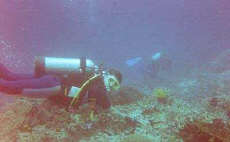

In the 4 knots current at a dive site off Bali, I have to hold on really hard. Note how my bubbles are going straight back.
![]()
![]()
On the 7th February 2001 my brother-in-law, Robert Allen, and I, Gary Brennand, went for a diving holiday to Bali. Nusa Pendia, an island off the east coast was to be our first dive at Bali, and pickup from our hotel was arranged for 7:30am, from where we were transported to our dive centres, Sea Star Dive Centre, head office in Sanur. Here we were greeted by Andy with a smile and very friendly welcome; we completed the paperwork and headed off to the boat. Once there all our dive gear was transferred to the boat for us, then after a quick intro to our travelling companions – Julie and Chris from Singapore, Ramon from Mexico – and we where on our way.
The Sea Star staff consisted of Marta, our dive master (yes, that’s one dive master for two divers, not bad considering a requirement to dive here is that you are an experienced diver); Andy, the dive master for Julie, Chris and Ramon; and there were also two boat crew.
The trip over to Nusa Pendia was a little over one hour to a dive site called Elementary, named after the grade school located on the shore. This site had a slight current and very clear water with a max. depth set for this dive of 25 meters (82 feet) and a visibility at 35m (115 ft). I think this was a site for the dive masters to check our skills before tackling Nusa Lembongan.
As soon as we entered the water two large potato cods showed themselves – at least until I put the camera to my eye, at which time they whipped into a small cave and out of sight. However, there were fish everywhere, and on we drifted to see them all. Marta pointed out a moray eel, but it too was a little camera shy and retracted back into its hole. After a very enjoyable dive the boat picked us up and we were taken to a quiet bay for lunch.
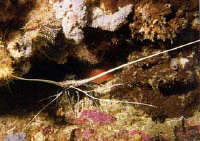

One of the few crays we saw, but I admit there was so much to see we weren’t really looking.
![]()
![]()
For our second dive we were taken to Nusa Lembongan. Marta gave us a run through of the dive site and the best way to tackle it: basically, go with the flow and try not to use your fins; if you wish to stop, find shelter behind a rock formation and grab hold of the bottom (while watching out for coral). Entry into the water was a back roll out of the side of the boat, and then grab hold of the mermaid line hanging from the back. The current was roaring at 4 knots, and just holding on to the line was hard enough.
Once we had all gathered on the line Marta gave the signal to let go. Well, what can I say, we were flying through the water. Even if you wanted to fin against the current it would be impossible; some of the large fish were having problems swimming into it. You keep your eyes peeled for a rock formation to hide behind so you can stop and have a good look around, but even here the bubbles from your regs are going straight back. Sticking your head around the corner of the formation lets the current just about rip your mask off, but this is the best way to get an idea of just how fast the current is going.
When we had finished our dive Marta sent up a buoy so the boat could locate us and come pick us up. The next trick was trying to get back on the boat. A tight grip is required when taking off your fins, or you will be whisked away – as my buddy found out. Upon returning to shore our gear was unloaded and packed into the car for us.
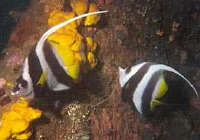

These Sweetlips were everywhere.
![]()
![]()
![]()
After being picked up from our hotel the next day, we arrived at Tulamben about one and a half hours later, although the drive didn’t seem that long as the scenery is magnificent all the way there. We headed straight for the drop-off dive site; unfortunately it was quite rough and way too dangerous to dive, and the waves were crashing into the rocks.
We proceeded to the Liberty wreck, a World War II casualty. It was torpedoed by a Japanese sub and limped to shore here, but during the Mt. Agung eruption in 1963 it slid back into the sea and sank 50m (164 ft) from the beach. There was a reasonable amount of surf here that we would have to work our way through, but it was driveable nevertheless. No sooner had our car stopped, than the locals had all our gear unpacked, on the beach and had started to rig it up for us. This is not something we were used to, and it took us a little by surprise. They did everything; I thought they were going to carry us into the water to save us the effort.
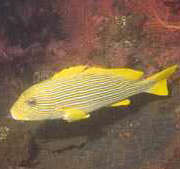

Bannerfish and coral have take over the Liberty wreck.
![]()
![]()
After checking our gear we worked our way out behind the surf and descended to about 8m (26 ft) where the wreck began. Due to the poor weather conditions the visibility was only about 10m (33 ft). The first thing you notice here is the colour of the sand. It is pitch black, a perfect contrast for all marine colours. We did two dives here and the marine life has well and truly taken over the wreck. There was healthy coral growth everywhere, and a large diversity of fish.
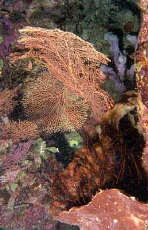

This sort of coral fills the wall, from 5m to at least 40m. We couldn’t see down any further, as the wall disappeared into blackness at Menjangan.
![]()
![]()
Menjangan Island, located in the far northwest corner of Bali about 3 1/2 hours from Kuta, was our next destination. We did three wall dives here. Could see the bottom at 45m (148 ft) on the first, but nothing but black on the second and third as the walls disappeared into the depths. Coral everywhere, lots of BIG fan coral and heaps of fish. The walls at this place are enormous. I’m not sure what depth they went to, but they started at 5m (16 ft) and dropped straight down – we couldn’t see the bottom.
During the dives we were just hanging at about 25m (82 ft) alongside the wall and being pushed along it by the current. A pair of fins got misplaced, so the person with the camera used two and the other two used one fin each. A bit of a pain, but you didn’t really need to use them as we had a current pushing us along. Bob was using two fins on the second dive, but one fell off and he lost it as it was whisked away in the current, so on the last dive we all swam with one fin each.
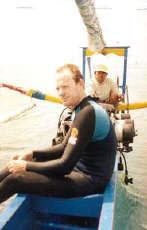

Yes this was the width of the boat! We had to hang our feet over the side.
![]()
![]()
Our next and last dive was to be at Padang Bai at a site called Shark Point. This was a one-and-a-half hour drive, and as usual everything was done for us when we arrived. The boat we were to head out in was a dug-out tree trunk with side riggers, and this gave us quite a steady ride considering the width of the boat. Segara, our Dive Master, gave us one warning: “If I signal a certain way to ascend, go straight to the boat and DON’T do a safety stop!”
Thoughts of sharks everywhere filled our thoughts, but we couldn’t wait to get in the water. We quickly got in and started looking for sharks, but there were none to be seen. The coral and fish life was still wonderful here, so we had something else to look at as we searched out the elusive animals. We ended our dive and proceeded back to the beach for a one-hour lunch break. Back out again to a site, a bit farther up the current, my first encounter of life was a psychotic triggerfish. It bit my fins three times and tried for my head many more. I had to fight it off with my camera. Apparently it was protecting its eggs, which must have been in the vicinity.
We continued on and began diving at the side of a steep embankment, when Segara signaled us to ascend to shallower water. He noticed our bubbles being pulled DOWN the embankment and into the never-never by the strong current. After looking around a bit more we ended our dive, and went back to the beach for another one-hour break. I took the opportunity to catch up on some much-needed sleep, and then it was off again for our last dive. We had decided to go to the other side of the bay to try our luck there, but we ended up leaving Bali not having seen any of the little critters.
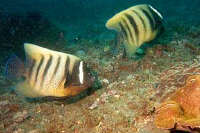

No sharks, just a pair of six-banded angelfish.
![]()
![]()
![]()
The dive at Nusa Lembongan was the best of all the dives we did at Bali. Only the beauty of the coral at Menjangan Island came close. The staff at Sea Star were fantastic. Marta, our dive master at Nusa Pendia and Tulamben, and Segara at Menjangan and Padang Bia, were the best dive masters we have ever dived with by a long shot.
It was a fantastic holiday, and the diving there was great. If you would like to see more photos of my trip, check out my web site: www.geocities.com/marinedomain.